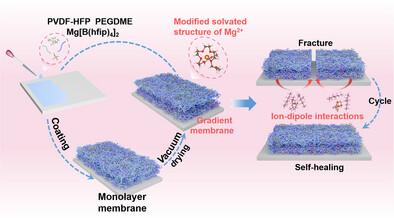A Universal Fluorinated Composite Interphase with Self-Healing Function Enabling Long-Cycling Rechargeable Magnesium Batteries
IF 19
1区 材料科学
Q1 CHEMISTRY, MULTIDISCIPLINARY
引用次数: 0
Abstract
Rechargeable magnesium batteries (RMBs) have significant advantages of high energy density, abundant resources and low dendrite tendency, positioning them as highly promising candidates for next-generation post-lithium-ion energy storage systems. However, poor reversibility and severe interfacial passivation at the Mg anode interface have hindered the viability and development of RMBs. In this work, a flexible multi-component fluoride-rich interface layer was constructed by coating organic polymers and inducing the reaction of Mg metal and organic magnesium salt. By adjusting the solvation structure of Mg2+ at the interface, rapid de-solvation and improved Mg2+ transport kinetics have been achieved. Additionally, ion-dipole interactions between-CF3 functional groups of the polymer and ion group from organic magnesium salt contribute to the enhanced electrochemical stability and self-healing capability of the interface layer during electrochemical cycling in various electrolytes. In consequence, the symmetric cells with modified Mganode demonstrates superior cycling stability for over 3500 hours. Full cells assembled with the B-PC@Mg anode, paired with either a novel polyanthraquinonylimid e-based composite cathode or a conventional Mo6S8 cathode, deliver significantly improved specific discharge capacities and enhanced capacity retention. This research provides a novel and straight forward strategy for designing Mg anode with high cycling stability in RMBs energy storage system.

一种具有自修复功能的通用氟化复合界面,可实现长周期可充电镁电池
可充电镁电池(RMBs)具有高能量密度、资源丰富、低枝晶化倾向等显著优势,是下一代后锂离子储能系统的重要候选材料。然而,可逆性差和Mg阳极界面钝化严重阻碍了RMBs的生存和发展。本文通过包覆有机聚合物,诱导金属镁与有机镁盐反应,构建了柔性的多组分富氟界面层。通过调整界面处Mg2+的溶剂化结构,实现了快速脱溶剂,改善了Mg2+的输运动力学。此外,聚合物的- cf3官能团与有机镁盐离子基之间的离子偶极相互作用有助于增强界面层在各种电解质中电化学循环过程中的电化学稳定性和自愈能力。因此,具有改性mg阳极的对称电池表现出超过3500小时的优越循环稳定性。与B-PC@Mg阳极组装的完整电池,与新型聚蒽醌酰亚胺基复合阴极或传统的Mo6S8阴极配对,可显着提高比放电容量和增强容量保持能力。本研究为RMBs储能系统中具有高循环稳定性的Mg阳极的设计提供了一种新颖而直接的策略。
本文章由计算机程序翻译,如有差异,请以英文原文为准。
求助全文
约1分钟内获得全文
求助全文
来源期刊

Advanced Functional Materials
工程技术-材料科学:综合
CiteScore
29.50
自引率
4.20%
发文量
2086
审稿时长
2.1 months
期刊介绍:
Firmly established as a top-tier materials science journal, Advanced Functional Materials reports breakthrough research in all aspects of materials science, including nanotechnology, chemistry, physics, and biology every week.
Advanced Functional Materials is known for its rapid and fair peer review, quality content, and high impact, making it the first choice of the international materials science community.
 求助内容:
求助内容: 应助结果提醒方式:
应助结果提醒方式:


